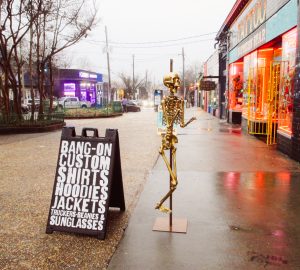SCAD’s “Fashtech Panel” details the innovative future of retail, customer experience and more

On January 26, students, alumni and fresh-faced industry workers gathered at SCAD Atlanta’s Digital Media Center to attend the “SCAD FashTech Panel,” organized and moderated by luxury and fashion management graduate student Sammantha Johnson.
The event page stated, “When most of us think of fashion, we think of fashion influencers, magazines, bloggers and our favorite stores. Technology seems to be an afterthought, but not in 2017. Retail fashion trends include providing customers with smarter on demand purchasing applications that save time and redefines the role of a selling associate.”
The panel discussion description promised networking opportunities, valuable knowledge on how to obtain a job through understanding the role technology plays and insider perspectives on how technology is changing the nature of retail and the customer experience. All this is, in part, due to the panelists’ combined knowledge of retail and user experience in relation to innovative technology.
After check-in, attendees chatted in the sitting areas outside the DMC’s theater, eating cheese and crackers and sipping on cold refreshments before being escorted into the theater, where guests took their seats and the panel commenced.
The three panelists chosen to share their insider experience on the changing technological nature of retail were Adrenaline Agency’s vice president of Digital Strategy Rick Barrick, Fittery founder Catherine Iger and Anastasia Simon, a sales consultant with Software Automation Inc.
Apart from being an avid music lover, Barrick’s primary task is to help clients express the values of their brand as effectively as possible, with the use of digital media strategies aimed at persuading the consumer that their brand is the right brand for them.
Catherine Iger’s Fittery, named “Top Innovator of the Year” by Apparel Magazine, produces algorithms to better fit clothing to consumers for companies. Iger’s company was awarded admittance into the highly competitive New York Fashion Tech Lab program, where Fittery was able to partner with department store giant Bloomingdales. The New York Fashion Tech Lab selects six to ten women-led companies each year that have shown great promise and progress in innovative practices that merge the fields of fashion, technology and retail. This 12-week program includes relevant workshops, mentorships, the chance to meet with investors, entrepreneurs and business executives and more. Although Iger’s company works with fashion retailers, she made clear the distinction that her company is a fashion tech company, emphasis on the tech, rather than the fashion aspect.
Simon initially trained to be a buyer, earning a Bachelor of Science in textiles and apparel merchandising from Louisiana State University. However, she decided to take a different path, eventually landing at Software Automation Inc., a company that makes robotic sewing machines. Though the youngest of the three panelists, Simon has already accrued an impressive decade of experience in her field.

When asked how retail companies can improve, technology-wise, in 2017, Rick Barrick had something to say. Barrick stated that good brands have stories to tell, referencing Victoria’s Secret as a prime example. Brands also need to be transcendent going forward to set them apart. The key components companies need to be able to do successfully in order to thrive in the marketplace are to tell a brand story, make purchasing easier, faster and frictionless, create a relationship with the consumer and interact with them on an intimate level.
Barrick went further into his anecdotal evidence from his decades of experience working with major fashion companies. When speaking about the importance of the brand knowing their consumer, he lamented how Victoria’s Secret, in its infancy after it was bought from the founder, used to play classical music in its stores. The reason? To make suburban moms, the brand’s then targeted consumer, to feel safer in the environment and more comfortable to walk in and ask the sales team questions. This choice of classical music was very strategic; it’s competitors, brands like Fredrick’s of Hollywood, implemented a sexier look as its marketing strategy. While typical for a lingerie brand, it intimidated the core consumer base that Victoria’s Secret was aiming to capture. When the brand decided to go global, it evolved into the sexier brand we know today.
“Brand vision must be all encompassing. It’s not just clothing. It envelops you in a lifestyle that you want to live.” — Rick Barrick.
Barrick, once again championing the brand above all else, emphasized how the age of technology has made the brand that much more important, since many different companies, essentially performing the same service or producing the same product, are so readily available to businesses, individuals and consumers via the internet. Recounting his time working with Abercrombie in its heyday, Barrick accounts that one of the reasons for the brand’s success was that the founder was so involved in every aspect of the company, down to the type of music he wanted to be played in the stores. “Bring the card, don’t bring the dad,” said Barrick in reference to Abercrombie’s strategy.
The founder of Fittery emphasized the importance of listening to your consumer, saying, “Go where your consumer wants to be, not where you want them to be. If your customers prefer to shop online, don’t try to make them shop in-store. Go online where they are.” Igor went on to offer key insights on what department stores are failing financially, saying, “Stores like Macy’s are holding onto an old model by not cutting stores fast enough and not trying to embrace e-commerce enough.”
“The magic of retail is to convince you that you need something that you don’t own, or to convince you that you don’t already have it.” — Catherine Igor.
Other noteworthy topics brought up were virtual reality’s role in the future dressing room experience as well as current technologies that monitor how long consumers stand in front of retail displays while recording facial expressions in response to what they see. Customization and personalization of both product and the customer experience were continually highlighted throughout the hour-long panel discussion.
Before the talk completed, the panelists had some advice to young professionals hoping to break into the fashion tech, retail and design industries.
Simon: “Stay open. Don’t be closed off to career paths. Don’t say, ‘I didn’t go to school for that’ or ‘this is not my job.’”
Igor: “Don’t be afraid to reject things that aren’t you or what you want to do.”
Barrick: “Don’t be afraid to fail fast or hard. You won’t get where you need to go by trying to be perfect. Spend your 20’s doing anything you can, gaining a variety of diverse experiences. Also, when you first start, don’t worry about climbing the ladder or your job title.”
The last thoughts spoken by the panelist before the conclusion of the event pulled the Q&A back to its key focus of fashion retail and technology. The brand is the most important thing. At the end of the day, technology is just a tool to emphasize that. Innovating the shopping experience is also key; there will always be a blend of digital and analog, the key is to find the perfect balance.
Crystal Paris, a third-year fashion student, said of the event, “I liked it! The panel really made us all think about how rapid technology is advancing within the fashion and retail industry.”
Taneisha James, a fourth-year fashion marketing and management student, shared her thoughts as well, saying, “The panel was very informative for me, and it was great to hear forward-thinkers in the industry. What they shared with us really helped to shift my ways of thinking about fashion, technology and where the two collide for problem-solving in the fashion/retail industry.”
Check back for an upcoming interview with event organizer and moderator Sammantha Johnson on the importance of the future of fashion, technology and retail.





















